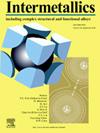Effect of elevated temperature and stress state on ductile fracture behaviors in titanium alloy: Experiments and modeling
IF 4.3
2区 材料科学
Q2 CHEMISTRY, PHYSICAL
引用次数: 0
Abstract
This research aims to characterize the effects of elevated temperature and stress state on the yield and fracture behavior of forged TC4 alloy. The uniaxial tensile, compression, and shear experiments were performed with different geometry under wide stress triaxiality at 760–800 °C. The experimental results indicate that the strength of TC4 titanium alloy decreases monotonously and unevenly with the temperature increase. The tension-compression asymmetry changes nonlinearly with temperature and strain, and this asymmetry decreases with increasing temperature. With the increase of stress triaxiality, the dimples in the fracture morphology become larger and deeper, and the ductile fracture mechanism changes from shear fracture to dimple fracture mechanism. A modified-JC constitutive model was proposed, and the coefficient of determination are about 0.981 and 0.971 for UTS and UCS. The temperature related yield function of Cazacu-Barlat2004 was constructed to describe the non-uniform evolution characteristics related to temperature and strain, and the fracture-related variables were calibrated with the hybrid experimental and numerical method under acceptable prediction accuracy. Finally, the temperature-related variables were successfully introduced into the DF2016 fracture model, and the fracture occurrence under different temperature and stress states were predicted with small prediction error. These research results can provide a basis for the shape and performance control of titanium alloy in the hot forming process.
求助全文
约1分钟内获得全文
求助全文
来源期刊

Intermetallics
工程技术-材料科学:综合
CiteScore
7.80
自引率
9.10%
发文量
291
审稿时长
37 days
期刊介绍:
This journal is a platform for publishing innovative research and overviews for advancing our understanding of the structure, property, and functionality of complex metallic alloys, including intermetallics, metallic glasses, and high entropy alloys.
The journal reports the science and engineering of metallic materials in the following aspects:
Theories and experiments which address the relationship between property and structure in all length scales.
Physical modeling and numerical simulations which provide a comprehensive understanding of experimental observations.
Stimulated methodologies to characterize the structure and chemistry of materials that correlate the properties.
Technological applications resulting from the understanding of property-structure relationship in materials.
Novel and cutting-edge results warranting rapid communication.
The journal also publishes special issues on selected topics and overviews by invitation only.
 求助内容:
求助内容: 应助结果提醒方式:
应助结果提醒方式:


